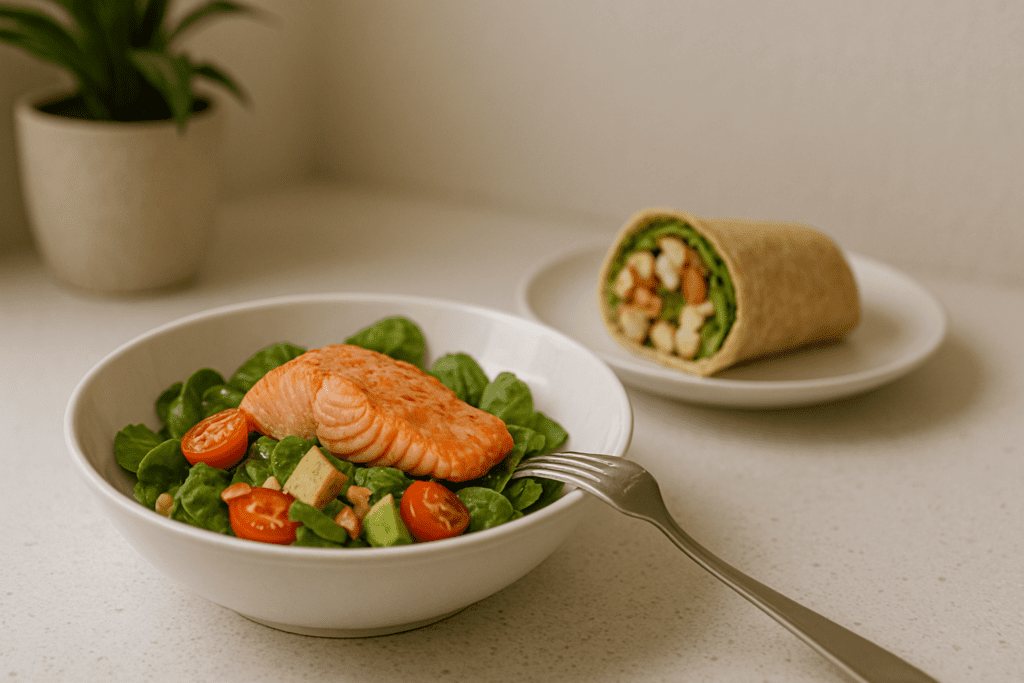In the fast-paced rhythm of modern life, particularly among professionals and college-educated individuals, maintaining consistent energy levels and mental clarity throughout the day has become an essential but often overlooked aspect of well-being. Many people focus on their breakfast and dinner choices while underestimating the impact of their midday meal. Yet, what we eat for lunch plays a critical role not only in physical stamina but also in cognitive performance and mood regulation. Understanding how light lunch recipes can enhance energy, improve focus, and support long-term health is crucial for anyone striving to optimize their daily productivity and wellness.
You may also like: Smart Healthy Eating Tips for Busy Professionals: How to Stay Nourished When You’re Always on the Go
The Importance of a Well-Balanced Midday Meal
Skipping lunch or opting for quick, ultra-processed foods may seem like a time-saver, but it can ultimately lead to afternoon fatigue, brain fog, and metabolic instability. Scientific literature consistently supports the concept that regular, nutrient-dense meals promote glucose stability and cognitive performance. A light lunch doesn’t mean a small or nutritionally inadequate one; rather, it refers to a meal that is appropriately portioned, rich in whole foods, and avoids excess fats and sugars that may slow digestion and reduce alertness.
To keep the body fueled and the mind alert, it’s essential that lunch includes complex carbohydrates, lean protein, healthy fats, and a variety of colorful vegetables. This balance not only provides sustained energy but also prevents the sharp insulin spikes that can cause post-lunch crashes. By choosing light lunch recipes that focus on whole, minimally processed ingredients, individuals can nourish themselves without feeling sluggish, bloated, or sleepy afterward.
How Light Lunch Recipes Support Cognitive Function
When it comes to mental focus, what you eat matters. Several nutrients commonly found in light lunch meals play a direct role in brain health. Omega-3 fatty acids, B-vitamins, and antioxidants like flavonoids have all been linked to improved memory, attention span, and even mood stability. For example, a light lunch consisting of grilled salmon over a mixed green salad with avocado and walnuts provides a trio of brain-supporting fats, fiber, and micronutrients.
Additionally, the glycemic load of a meal can impact how alert or drowsy someone feels. Meals high in refined carbohydrates can lead to a rapid rise and fall in blood sugar, creating a cycle of fatigue and hunger. In contrast, a balanced light lunch with slow-digesting carbohydrates, such as quinoa, brown rice, or sweet potatoes, offers a more gradual energy release, helping maintain cognitive sharpness into the afternoon.
A strategically designed lunch can also reduce the need for excessive caffeine or sugary snacks later in the day. By focusing on meals that offer satiety without overloading the digestive system, individuals may find their afternoon productivity naturally improving without artificial stimulants.
Nutrition Science Behind Energy-Boosting Foods
There is a growing body of research indicating that diet has a measurable impact on energy metabolism. Nutrients like iron, magnesium, and vitamin C all play a role in the production and utilization of cellular energy. Leafy greens, legumes, citrus fruits, and lean animal proteins are some of the most effective sources of these energy-enhancing nutrients and are often featured in thoughtfully prepared light lunch recipes.
For example, a Mediterranean-style chickpea salad with cherry tomatoes, cucumbers, parsley, and olive oil not only provides fiber and plant-based protein but also contains essential minerals that support mitochondrial function. The synergy of these ingredients helps promote consistent energy levels without the drag associated with heavier meals high in saturated fat.
Incorporating fermented foods such as kimchi or yogurt into lunch can also support gut health, which is increasingly recognized as a key player in overall energy and immune function. A healthy gut microbiome aids in the digestion and absorption of nutrients, further enhancing the effectiveness of a nutritious light lunch.

Meal Timing and Its Influence on Productivity
The timing of lunch can have a significant effect on how the body processes food and maintains energy throughout the day. Eating too late may result in intense hunger, leading to overeating or poor food choices. On the other hand, eating too early may leave you feeling drained by mid-afternoon. Experts recommend consuming a light lunch approximately four to five hours after breakfast to ensure optimal glucose regulation and satiety.
Additionally, taking the time to eat mindfully rather than rushing through lunch can enhance digestion and allow the body to properly register satiety cues. This approach supports the principles of mindful eating, which is associated with better portion control, reduced emotional eating, and improved satisfaction with meals. Scheduling lunch breaks and treating them as non-negotiable appointments can be a practical way to reinforce the habit of eating well.
A mindful approach also extends to where and how you eat. Eating at a desk while working or scrolling through emails may detract from the quality of digestion and mental refreshment that a well-prepared lunch can offer. Whenever possible, stepping away from work for even 20 minutes to enjoy a balanced light lunch can make a notable difference in afternoon productivity and mood.
Common Mistakes to Avoid When Preparing Light Lunches
Many people equate “light” with “low-calorie,” leading them to consume meals that are too small or lacking in essential nutrients. A light lunch should be satisfying and sustaining without being heavy or greasy. Meals that lack protein or healthy fats can leave you feeling hungry within an hour, setting the stage for poor snack choices and disrupted energy levels.
Another common pitfall is relying too heavily on pre-packaged or convenience foods labeled as healthy. While these options may be low in calories, they are often high in sodium, preservatives, and added sugars. Preparing light lunch recipes from scratch ensures greater control over ingredients and helps avoid the hidden downsides of many store-bought meals.
Portion control can also be misunderstood. Some individuals eat oversized portions of salads or grain bowls without balancing them with adequate protein or fat, resulting in blood sugar fluctuations and eventual fatigue. Learning how to balance macronutrients in appropriate proportions is essential for crafting a truly effective light lunch.

Embracing the Connection Between Food and Mental Health
Beyond physical health and productivity, the benefits of eating well at lunchtime extend into mental and emotional well-being. The gut-brain connection, now widely recognized in medical research, suggests that what we eat influences our mood, stress levels, and even resilience to mental fatigue. Meals rich in omega-3s, fiber, and fermented foods can promote the growth of beneficial gut bacteria, which in turn produce neurotransmitters like serotonin and dopamine.
By choosing light lunch recipes that support gut health and minimize inflammation, individuals can enhance not only their physical energy but also their emotional balance. Feeling nourished and stable in the middle of the day creates a foundation for more consistent emotional regulation, better interpersonal interactions, and improved decision-making.
Mindfully consuming a balanced lunch can also serve as a grounding ritual during stressful workdays. Taking time to slow down, enjoy food, and nourish oneself is a powerful act of self-care that can reset both body and mind. As the dialogue around mental wellness continues to evolve, the role of nutrition deserves a more prominent place in personal and public health strategies.
Frequently Asked Questions (FAQ): Smart Light Lunch Recipes for Energy and Focus
What are some creative ways to upgrade traditional light lunch recipes without adding heaviness?
Elevating classic light lunch recipes doesn’t have to involve heavier ingredients. One way to enhance both flavor and nutrition is by introducing global ingredients such as za’atar, miso, or turmeric to traditional wraps or grain bowls. For example, swapping plain hummus for turmeric-infused hummus can add anti-inflammatory benefits and bold flavor. Incorporating pickled vegetables or fermented toppings like kimchi offers both a tangy twist and gut-health support. These small yet thoughtful upgrades keep your light lunch exciting while maintaining its lightness and digestibility.
How can a light lunch help reduce dependence on caffeine in the afternoon?
A well-structured light lunch can stabilize blood sugar and provide slow-burning fuel, which helps maintain energy without the spikes and crashes associated with caffeine. Many people reach for coffee when their energy dips mid-afternoon, often due to a heavy or unbalanced lunch. By choosing light lunch recipes rich in complex carbohydrates, healthy fats, and protein—such as a quinoa and avocado salad or a tuna and white bean bowl—you can stay energized without needing a second or third cup of coffee. These meals sustain neurotransmitter function and reduce mental fatigue naturally. Over time, you’ll notice greater mental clarity and fewer caffeine cravings when your midday meal is properly balanced.
Is it possible to prepare light lunch recipes that support intermittent fasting schedules?
Yes, and in fact, light lunch options can complement intermittent fasting by preventing the sluggishness that sometimes follows a large post-fast meal. The key is nutrient density rather than volume. For those breaking a fast at lunch, dishes like spinach and egg muffins with roasted veggies or a smoked salmon salad with lemon vinaigrette provide ample nutrition without overwhelming the digestive system. These meals ease the body back into digestion and prepare you for a productive afternoon. Planning your light lunch to align with your fasting window can optimize both metabolic health and sustained energy.
Can light lunch meals support emotional well-being and stress regulation?
Absolutely. Certain nutrients in well-designed light lunch recipes—such as magnesium, omega-3 fatty acids, and B vitamins—play crucial roles in mood stability and stress response. Meals that include leafy greens, legumes, and fatty fish provide these nutrients in bioavailable forms. Additionally, the act of pausing to eat a light lunch mindfully can reduce cortisol levels by encouraging a parasympathetic (rest-and-digest) state. Foods like dark leafy greens and seeds also support serotonin production, further aiding emotional regulation. Making lunchtime a moment of nourishment rather than stress can transform it into a daily wellness ritual.
How do cultural dietary traditions influence the design of light lunch recipes?
Around the world, many cultures naturally embrace the concept of a light lunch without labeling it as such. For example, in Mediterranean countries, lunches often feature vegetables, olives, whole grains, and lean proteins in moderate portions—all staples of light lunch philosophy. Japanese bento boxes use a similar approach with small portions of rice, fish, and vegetables that prioritize balance and variety. Drawing inspiration from these traditions allows for innovative yet nutritionally sound recipes that emphasize freshness and moderation. By integrating global flavors, you can create light lunch meals that are both diverse and deeply satisfying.
What role does hydration play in maximizing the benefits of a light lunch?
Hydration often goes unnoticed in discussions about meal planning, yet it plays a critical role in energy metabolism and digestion. Drinking water before and after your light lunch supports nutrient absorption and prevents fatigue that may be mistaken for hunger. Adding hydrating foods to your lunch—such as cucumbers, watermelon, or leafy greens—can amplify the overall effect. Herbal teas or infused waters are also excellent accompaniments to a light lunch, especially for those reducing caffeine. Staying hydrated ensures that your light lunch delivers on its promise of focus and energy.
Are there specific light lunch recipes that can help reduce inflammation?
Yes, certain foods featured in anti-inflammatory diets are perfect for light lunch recipes. Ingredients like turmeric, ginger, wild-caught fish, berries, and leafy greens can help reduce systemic inflammation when incorporated into lunch. A grilled trout bowl with kale and pomegranate seeds, or a turmeric lentil salad with arugula and beets, exemplifies this approach. These meals offer robust antioxidant and phytonutrient profiles while remaining easy to digest. Regularly consuming such lunches may contribute to reduced joint pain, better digestion, and even clearer skin over time.
How can individuals meal prep light lunch options for a busy workweek?
Strategic batch-cooking is the key to light lunch meal prep without sacrificing freshness. Prepare a few versatile components like roasted vegetables, cooked grains, or marinated tofu that can be mixed and matched throughout the week. For instance, quinoa can be the base for several light lunch recipes, paired one day with chickpeas and tahini and another with grilled chicken and citrus. Mason jar salads layered for freshness and simple homemade vinaigrettes can streamline lunch assembly. With just two hours of prep on a weekend, you can create enough variety to avoid repetition while staying committed to healthy habits.
Are there light lunch options suitable for people with food sensitivities or allergies?
Certainly. One of the strengths of light lunch recipes is their flexibility to accommodate various dietary needs. Gluten-free grains like buckwheat, rice, or millet can replace traditional pasta or bread, while plant-based proteins such as lentils or tempeh can substitute for dairy or animal products. For those avoiding nuts, sunflower seed butter or hemp seeds offer excellent alternatives. Creating a roster of allergen-friendly light lunch ideas ensures inclusivity without compromising nutrition or taste. As awareness of food sensitivities grows, so too does the innovation in accommodating recipes.
What are the long-term benefits of consistently choosing light lunch meals over heavier alternatives?
Over time, choosing lighter, nutrient-dense meals for lunch can improve metabolic flexibility, digestion, and cognitive function. Many individuals find that their evening appetite becomes more balanced and their overall caloric intake naturally regulates without the need for restrictive dieting. Light lunch recipes, when chosen wisely, support mitochondrial health, reduce oxidative stress, and promote hormonal balance. Additionally, individuals often report more stable moods and improved sleep quality due to better blood sugar control throughout the day. These long-term benefits reflect the power of consistent, intentional nutrition decisions made one meal at a time.

Savoring the Midday Meal as a Foundation for Healthier Living
At its core, the concept of a light lunch is not about restriction or minimalism but about making thoughtful, nourishing choices that support the full spectrum of human functioning. From physical energy and cognitive focus to emotional well-being and chronic disease prevention, the benefits of a balanced midday meal are far-reaching and deeply rooted in both science and daily experience.
Light lunch recipes offer an accessible, practical, and enjoyable path to better health. By embracing meals that are light in heaviness but rich in nutrients, individuals can transform their lunch hour into a meaningful contributor to their overall lifestyle. Whether enjoyed at home, in the office, or on the go, a well-crafted light lunch can serve as a keystone habit that reinforces broader patterns of wellness, self-awareness, and intentional living.
In a culture that often encourages overwork and undervalues rest, reclaiming the lunch hour as a moment for nourishment and reflection is a radical yet essential act. Through small, consistent choices rooted in evidence-based nutrition, we have the power to fuel not only our bodies but our ambitions, creativity, and long-term vitality.
healthy lunch ideas, brain-boosting foods, energizing meals, midday meal tips, wellness lunch strategies, clean eating habits, nutrient-dense recipes, balanced diet lunch, anti-fatigue meals, workday nutrition, simple healthy recipes, gut health foods, focus-enhancing meals, meal planning for professionals, heart-healthy lunches, immune-supporting meals, cognitive nutrition, whole food lunch options, inflammation-reducing diet, plant-based lunch meals
Further Reading:
70 Healthy Lunch Ideas for Seriously Delicious Midday Fuel
28 Easy and Healthy Meals for Breakfast, Lunch, and Dinner
12 Healthy Lunch Recipes For When You Need an Energy Boost
Disclaimer
The information contained in this article is provided for general informational purposes only and is not intended to serve as medical, legal, or professional advice. While NewsHealthWatch strives to present accurate, up-to-date, and reliable content, no warranty or guarantee, expressed or implied, is made regarding the completeness, accuracy, or adequacy of the information provided. Readers are strongly advised to seek the guidance of a qualified healthcare provider or other relevant professionals before acting on any information contained in this article. NewsHealthWatch, its authors, editors, and contributors expressly disclaim any liability for any damages, losses, or consequences arising directly or indirectly from the use, interpretation, or reliance on any information presented herein. The views and opinions expressed in this article are those of the author(s) and do not necessarily reflect the official policies or positions of NewsHealthWatch.

